Investigation on Preparation Process and Storage Stability of Modified Asphalt Binder by Grafting Activated Crumb Rubber
Abstract
:1. Introduction
2. Experimental
2.1. Materials
2.2. Grafting Activation of Crumb Rubber
2.3. Preparation of A-R-G
2.4. Test Methods
3. Results and Discussion
3.1. Influence of Different Factors on the High Temperature Performance
3.2. Influence of Different Factors on the Low Temperature Performance
3.3. Influence Extent of Different Factors on the Properties of A-G-R
3.4. Storage Stability
3.5. Morphology
4. Conclusions
Author Contributions
Funding
Conflicts of Interest
References
- Lv, S.; Xia, C.; Liu, C.; Zheng, J.; Zhang, F. Fatigue equation for asphalt mixture under low temperature and low loading frequency conditions. Constr. Build. Mater. 2019, 211, 1085–1093. [Google Scholar] [CrossRef]
- Lv, S.; Fan, X.; Yao, H.; You, L.; You, Z.; Fan, G. Analysis of performance and mechanism of Buton rock asphalt modified asphalt. J. Appl. Polym. Sci. 2018, 46903. [Google Scholar] [CrossRef]
- Fang, Y.; Zhan, M.; Wang, Y. The status of recycling of waste rubber. Mater. Des. 2001, 22, 123–128. [Google Scholar] [CrossRef]
- Zhou, H.P.; Holikatti, S.; Vacura, P. Caltrans use of scrap tires in asphalt rubber products: A comprehensive review. J. Traffic Transp. Eng. 2014, 1, 39–48. [Google Scholar] [CrossRef]
- Li, H.Y.; Jiang, H.L.; Zhang, W.W.; Liu, P.; Wang, S.S. Laboratory and field investigation of the feasibility of crumb rubber waste application to improve the flexibility of anti-rutting performance of asphalt pavement. Materials 2018, 11, 1738. [Google Scholar] [CrossRef] [PubMed]
- Li, B.; Zhou, J.; Zhang, Z.; Yang, X.; Wu, Y. Effect of short-term aging on asphalt modified using microwave activation crumb rubber. Materials 2019, 12, 1039. [Google Scholar] [CrossRef] [PubMed]
- Xiao, F.; Zhao, P.W.; Amirkhanian, S.N. Fatigue behavior of rubberized asphalt concrete mixtures containing warm asphalt additives. Constr. Build. Mater. 2009, 23, 3144–3151. [Google Scholar] [CrossRef]
- Navarro, F.J.; Partal, P.; MartíNez-Boza, F.; Gallegos, C. Thermo-rheological behaviour and storage stability of ground tire rubber-modified bitumens. Fuel 2004, 83, 2041–2049. [Google Scholar] [CrossRef]
- Pais, J.; Lo Presti, D.; Santos, C.; Thives, L.; Pereira, P. The effect of prolonged storage time on asphalt rubber binder properties. Constr. Build. Mater. 2019, 210, 242–255. [Google Scholar] [CrossRef]
- Li, B.; Huang, W.; Tang, N.; Hu, J.; Lin, P. Evolution of components distribution and its effect on low temperature properties of terminal blend rubberized asphalt binder. Constr. Build. Mater. 2017, 136, 598–608. [Google Scholar] [CrossRef]
- Huang, W.; Lin, P.; Tang, N.; Hu, J.; Xiao, F. Effect of crumb rubber degradation on components distribution and rheological properties of Terminal Blend rubberized asphalt binder. Constr. Build. Mater. 2017, 151, 897–906. [Google Scholar] [CrossRef]
- Han, L.; Zheng, M.; Wang, C. Current status and development of terminal blend tyre rubber modified asphalt. Constr. Build. Mater. 2016, 128, 399–409. [Google Scholar] [CrossRef]
- Liu, H.; Chen, Z.; Wang, W.; Wang, H.; Hao, P. Investigation of the rheological modification mechanism of crumb rubber modified asphalt ((CRMA) containing TOR additive. Constr. Build. Mater. 2014, 67, 225–233. [Google Scholar] [CrossRef]
- Ghaly, N. Effect of sulfur on the storage stability of tire rubber modified asphalt. World J. Chem. 2008, 3, 42–50. [Google Scholar]
- Ouyang, C.; Gao, Q.; Shi, Y.; Shan, X. Compatibilizer in waste tire powder and low-density polyethylene blends and the blends modified asphalt. J. Appl. Polym. Sci. 2012, 123, 485–492. [Google Scholar] [CrossRef]
- Wang, S.; Yuan, C.; Deng, J. Crumb tire rubber and polyethylene mutually stabilized in asphalt by screw extrusion. J. Appl. Polym. Sci. 2015, 131, 81–86. [Google Scholar] [CrossRef]
- Memon, M. Homogeneous Crumb Rubber Modified Asphalt. U.S. Patent 5,704,971, 6 January 1998. [Google Scholar]
- Sienkiewicz, M.; Borzędowska-Labuda, K.; Wojtkiewicz, A.; Janik, H. Development of methods improving storage stability of bitumen modified with ground tire rubber: A review. Fuel Process. Technol. 2017, 159, 272–279. [Google Scholar] [CrossRef]
- Shatanawi, K.M.; Biro, S.; Geiger, A.; Amirkhanian, S.N. Effects of furfural activated crumb rubber on the properties of rubberized asphalt. Constr. Build. Mater. 2012, 28, 96–103. [Google Scholar] [CrossRef]
- Liang, M.; Xin, X.; Fan, W.; Ren, S.; Shi, J. Thermo-stability and aging performance of modified asphalt with crumb rubber activated by microwave and TOR. Mater. Des. 2017, 127, 84–96. [Google Scholar] [CrossRef]
- Li, J.; Xie, J.; Ma, Y. Experimental investigation on preparation and performance ofmodified asphalt by crumb rubber of coating activation. Bull. Chin. Ceram. Soc. 2018, 37, 3179–3186,3192. [Google Scholar] [CrossRef]
- Lo Presti, D. Recycled tyre Rubber modified bitumens for road asphalt mixtures: A literature review. Constr. Build. Mater. 2013, 49, 863–881. [Google Scholar] [CrossRef]
- Kök, B.V.; Yilmaz, M.; Geçkil, A. Evaluation of low-temperature and elastic properties of crumb rubber–and SBS-modified bitumen and mixtures. J. Mater. Civ. Eng. 2012, 25, 257–265. [Google Scholar] [CrossRef]
- Zanzotto, L.; Kennepohl, G.J. Development of rubber and asphalt binders by depolymerization and devulcanization of scrap tires in asphalt. Transp. Res. Rec. 1996, 1530, 51–58. [Google Scholar] [CrossRef]
- Airey, G.; Singleton, T.; Collop, A. Properties of polymer modified bitumen after rubber-bitumen interaction. J. Mater. Civ. Eng. 2002, 14, 344–354. [Google Scholar] [CrossRef]
- Galooyak, S.S.; Dabir, B.; Nazarbeygi, A.E.; Moeini, A. Rheological properties and storage stability of bitumen/SBS/montmorillonite composites. Constr. Build. Mater. 2010, 24, 300–307. [Google Scholar] [CrossRef]
- Dong, F.; Xin, Y.; Chen, J.; Liu, S.; Qiao, C. Investigation on compatibility and microstructure of PCBs-modified asphalt. J. Appl. Polym. Sci. 2017, 134, 44798. [Google Scholar] [CrossRef]
- Qian, C.; Fan, W.; Liang, M.; He, Y.; Ren, S. Rheological properties, storage stability and morphology of CR/SBS composite modified asphalt by high-cured method. Constr. Build. Mater. 2018, 193, 312–322. [Google Scholar] [CrossRef]

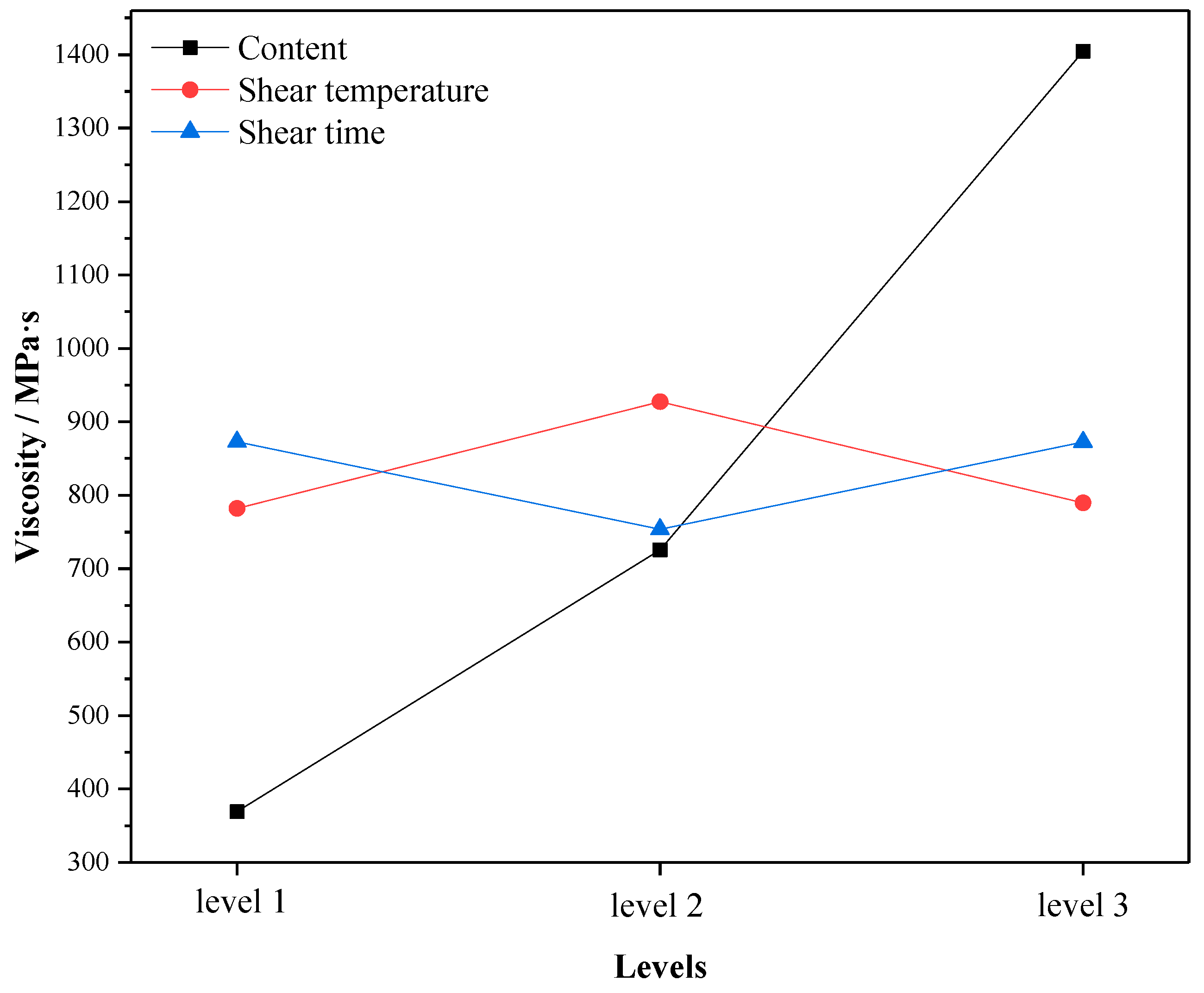
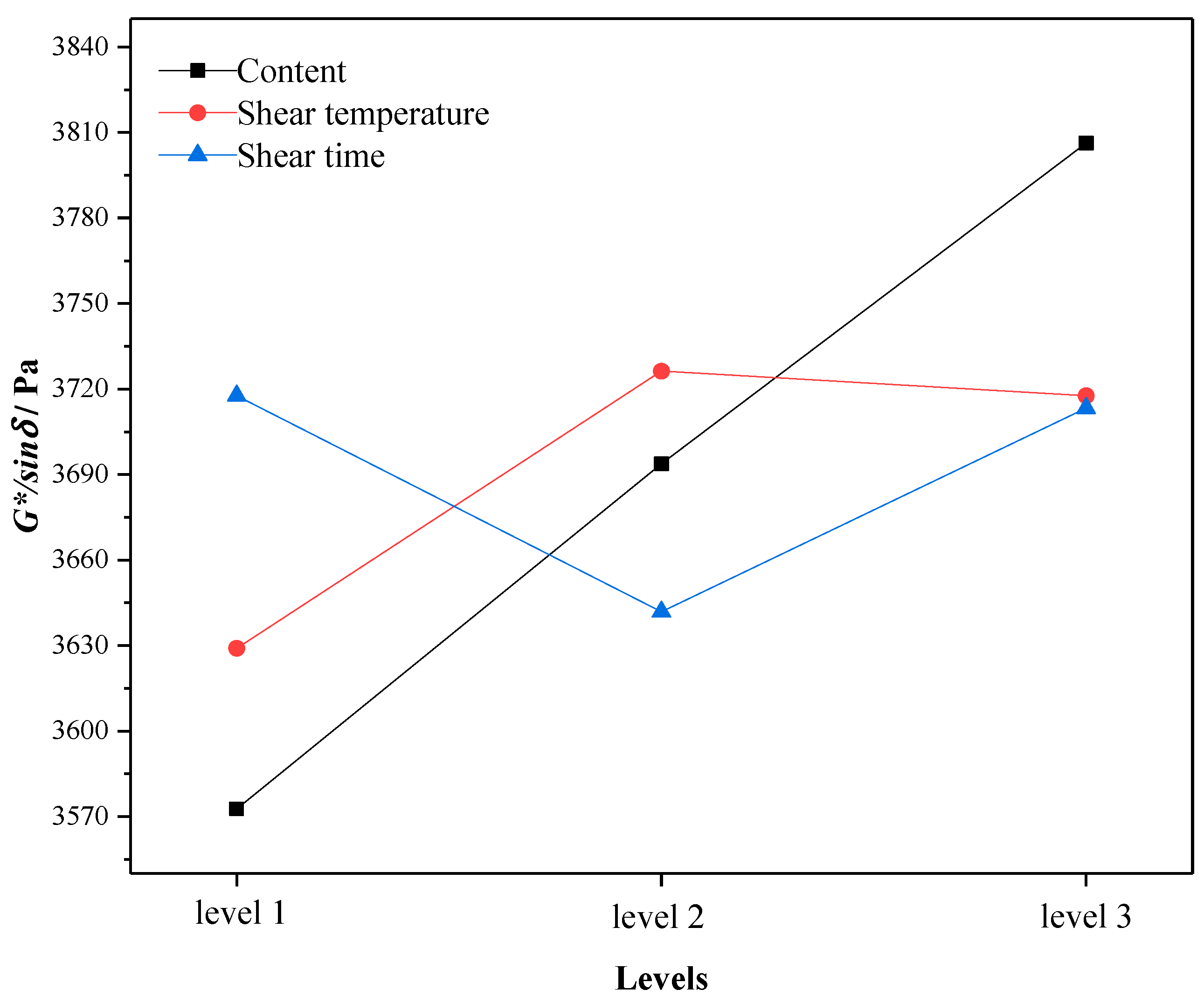
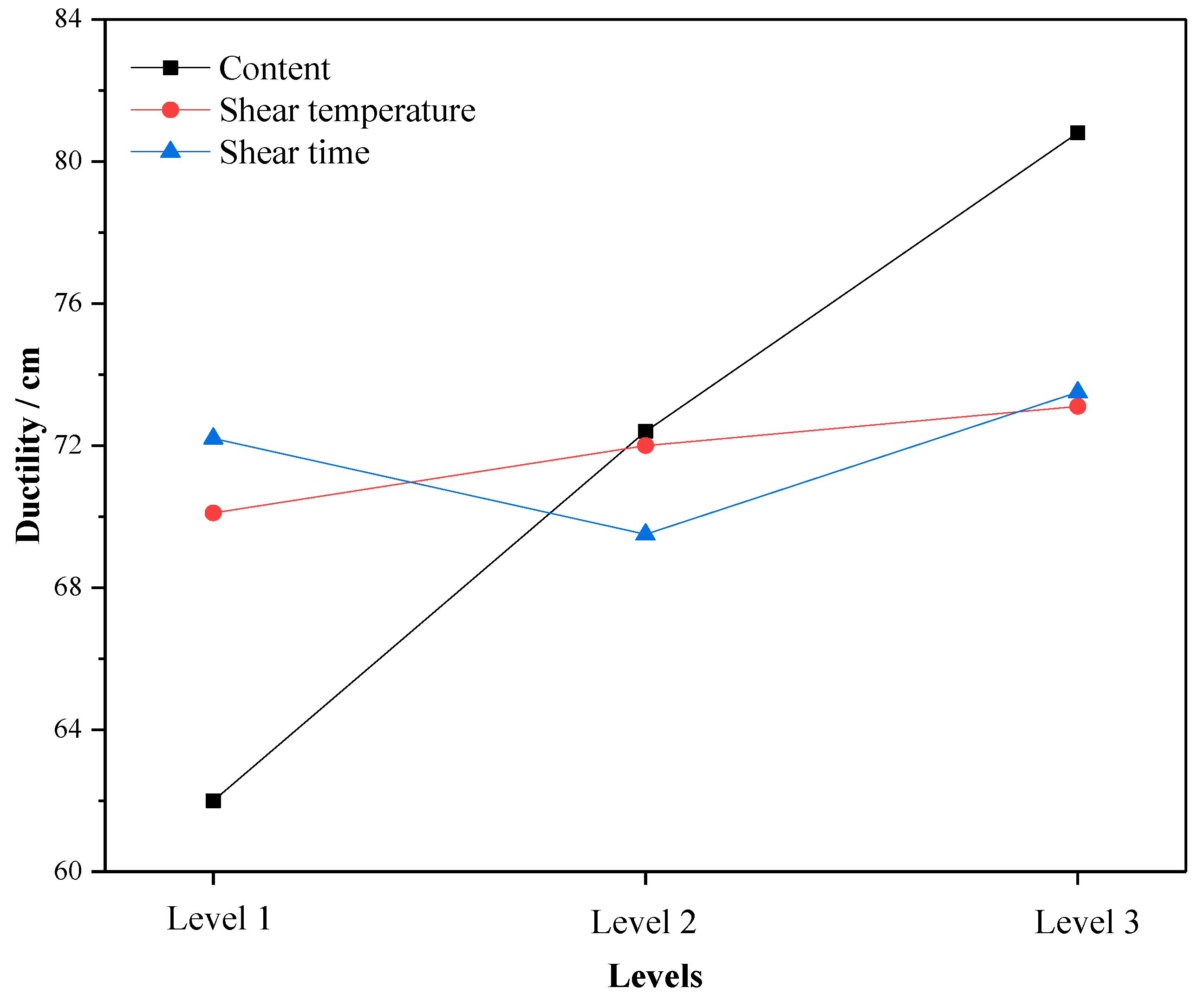
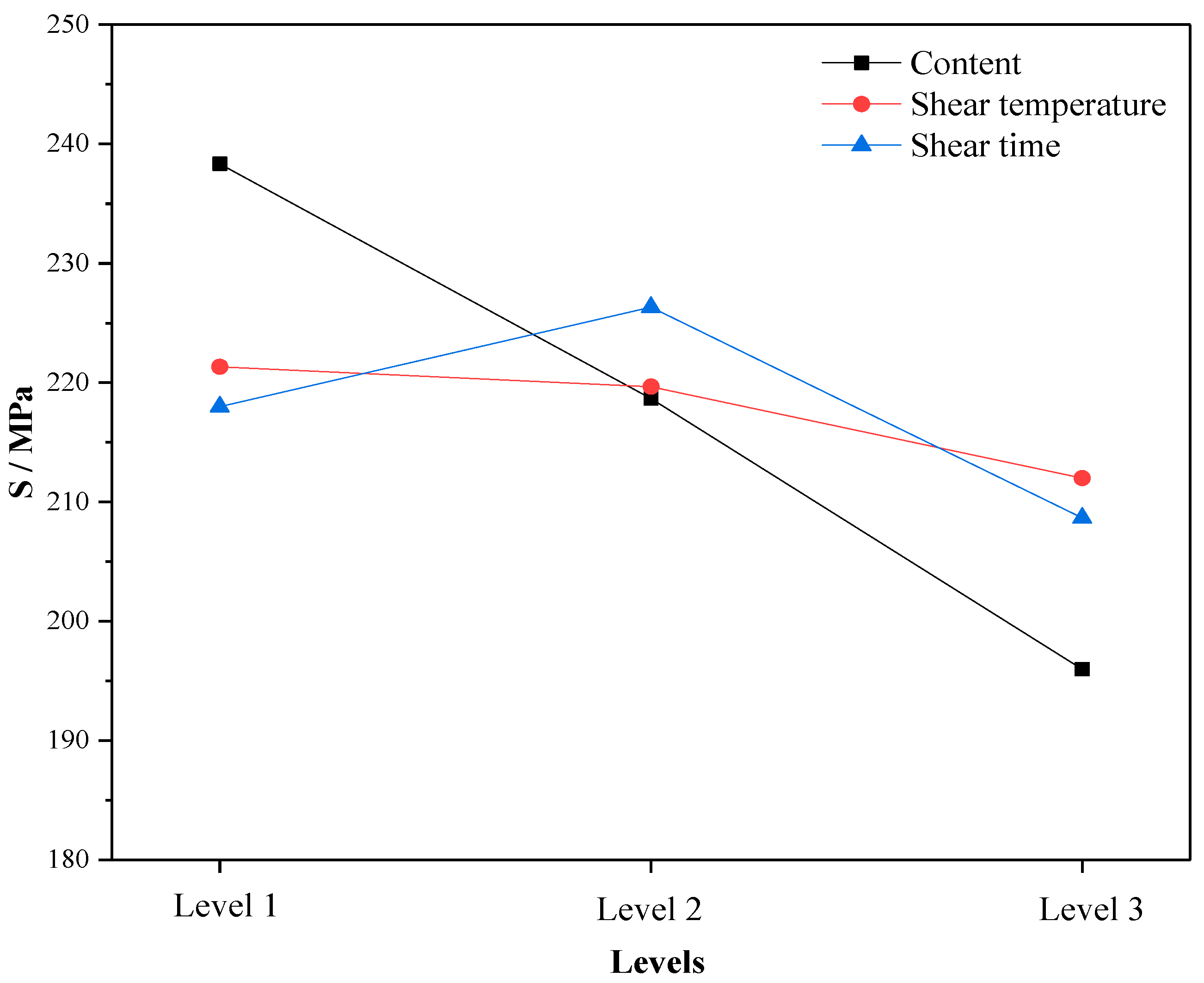
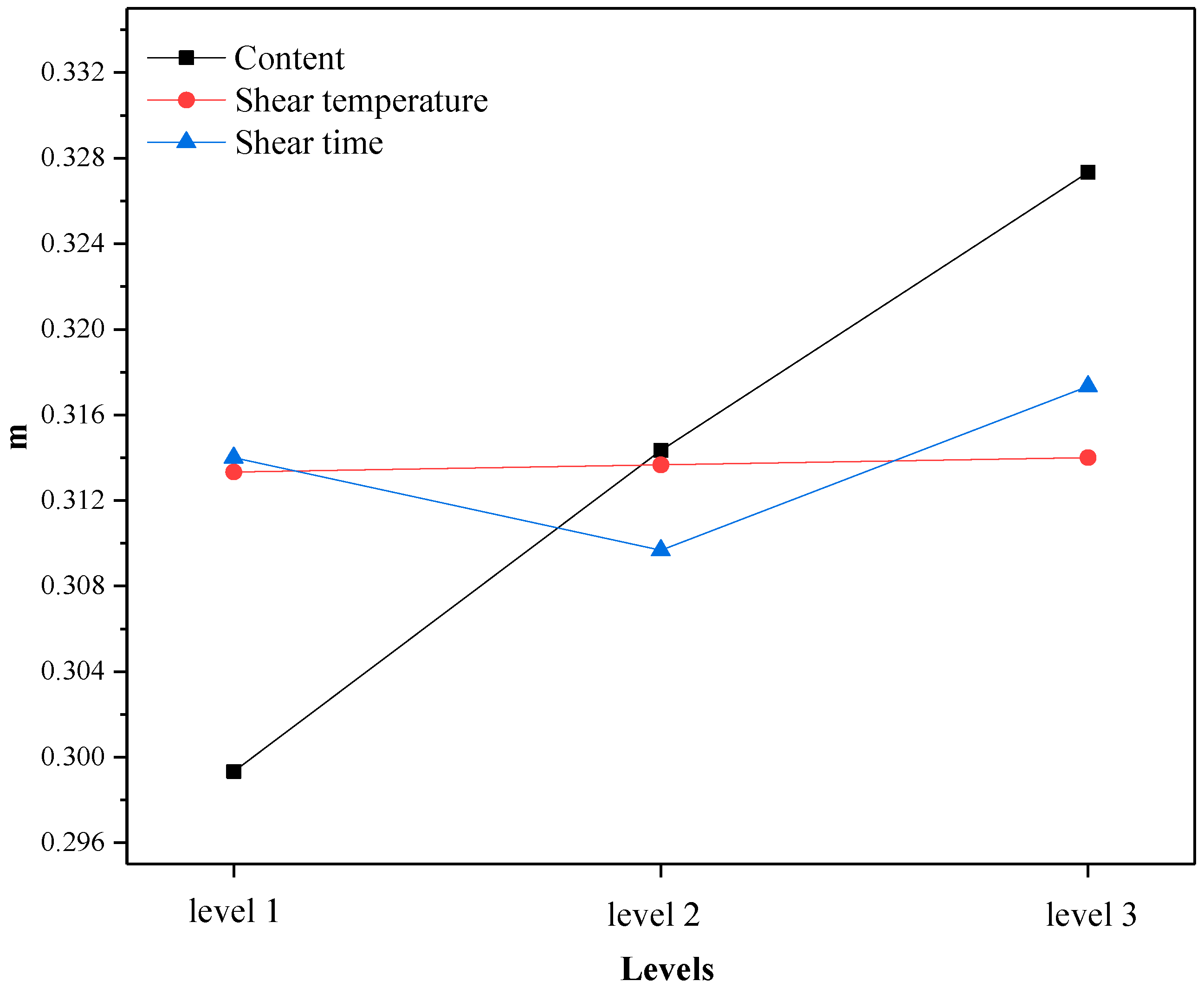

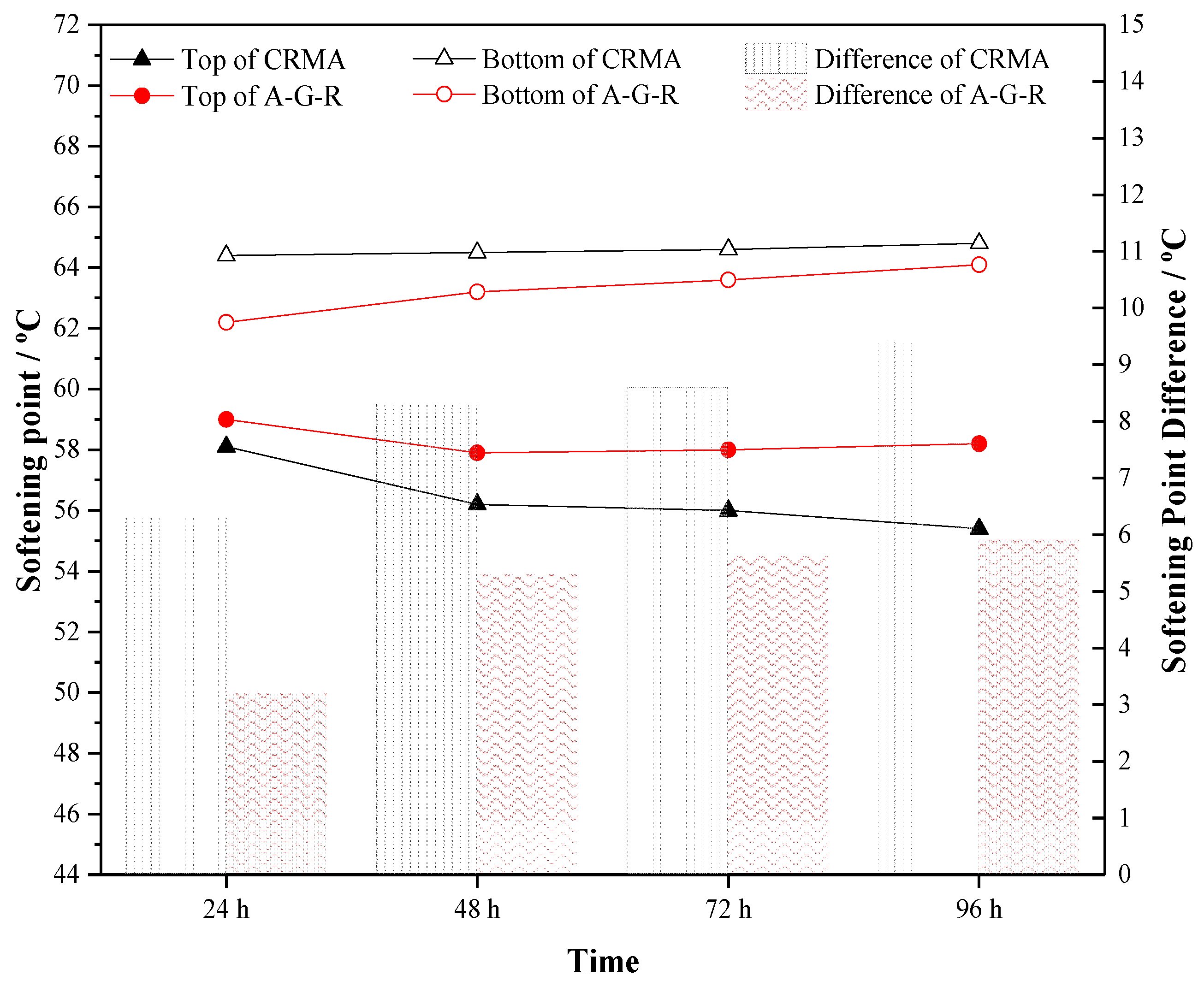
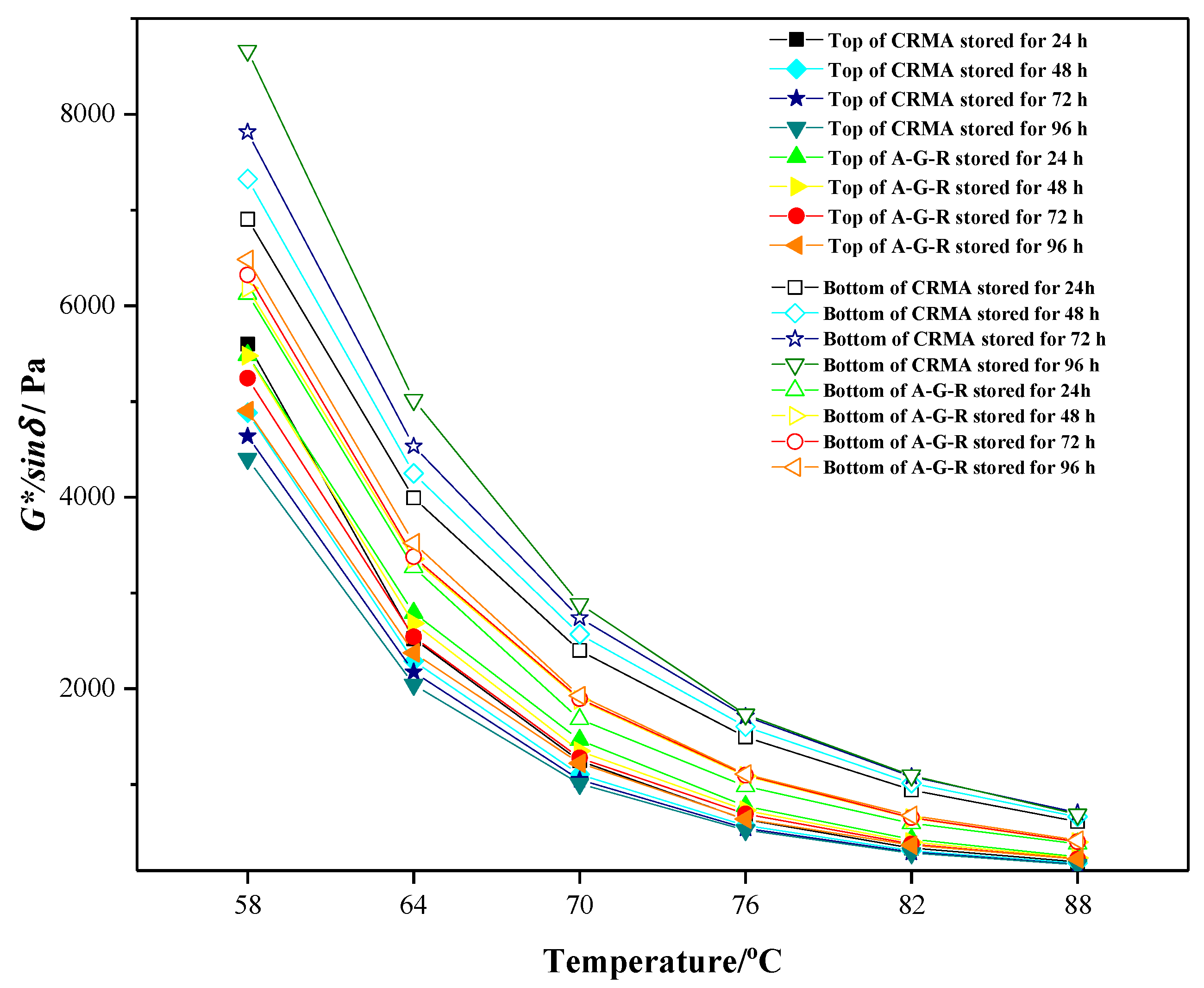

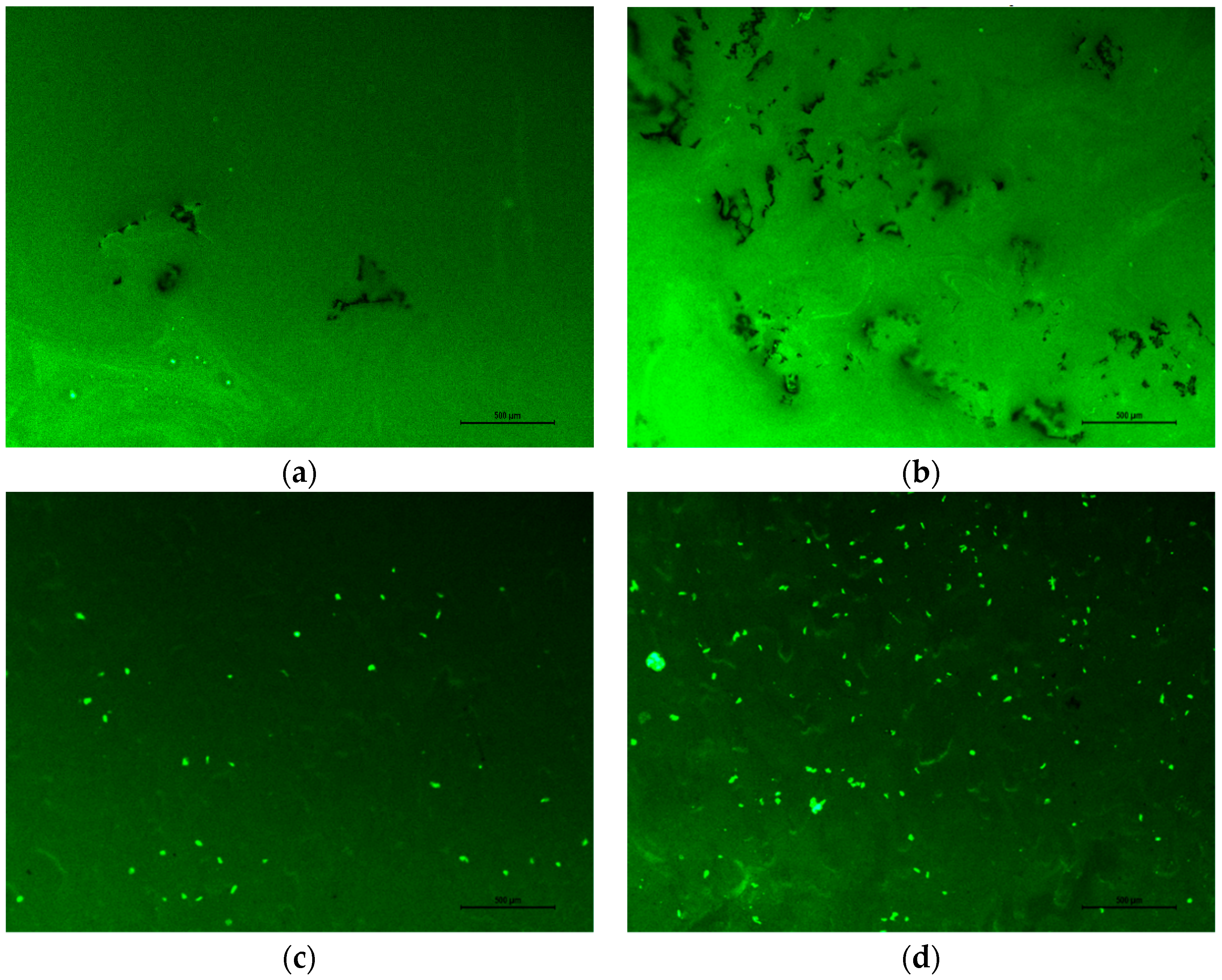
| Item | Units | Test Results | Standard |
|---|---|---|---|
| Penetration (25 °C, 100 g, 5s) | 0.1 mm | 78.1 | JTG-T0604-2011 |
| Softening temperature | °C | 44.9 | JTG -T0606-2011 |
| Ductility (5 °C, 5 cm/min) | cm | >100 | JTG-T0605-2011 |
| Kinematic viscosity (135 °C) | Pa s | 108.5 | JTG-T0625-2011 |
| Density | g/cm3 | 1.009 | JTG-T0603-2011 |
| RTFO treated at 163 °C for 85 min | |||
| Quality change | % | −0.063 | JTG-T0610-1-2011 |
| Residual penetration ratio (25 °C) | % | 57.5 | JTG-T0610-2-2011 |
| Residual ductility (5 °C) | cm | 8.9 | JTG-T0605-2011 |
| Item | Result | Standard |
|---|---|---|
| Water content (%) | 0.98 | HG/TXXX-2001 7.2.2 |
| Ash content (%) | 9.2 | GB4498 |
| Acetone extract content (%) | 13.5 | GB/T3516 |
| Density (g/cm3) | 0.95 | GB/T533 |
| Tensile strength (MPa) | 6.5 | GB/T528 |
| Elongation at break (%) | 860 | GB/T52 |
| Number | Factors and Levels | ||
|---|---|---|---|
| Content (%) | Shear Temperature (°C) | Shear Time (min) | |
| 1 | 10 | 150–170 | 30 |
| 2 | 10 | 170–190 | 90 |
| 3 | 10 | 190–210 | 60 |
| 4 | 15 | 150–170 | 90 |
| 5 | 15 | 170–190 | 60 |
| 6 | 15 | 190–210 | 30 |
| 7 | 20 | 150–170 | 60 |
| 8 | 20 | 170–190 | 30 |
| 9 | 20 | 190–210 | 90 |
| Number | 1 | 2 | 3 | 4 | 5 | 6 | 7 | 8 | 9 |
|---|---|---|---|---|---|---|---|---|---|
| Softening point/ | 54.3 | 56.0 | 54.9 | 56.5 | 56.5 | 57.8 | 57.0 | 59.8 | 59.2 |
| 175 °C Viscosity/MPa·s | 333.3 | 470.5 | 303.7 | 771.6 | 715.9 | 689.8 | 1242.0 | 1595.6 | 1375.8 |
| 60 °C rutting factor/Pa | 3523.0 | 3633.3 | 3561.9 | 3665.7 | 3665.7 | 3750.1 | 3698.2 | 3879.8 | 3840.9 |
| Number | 1 | 2 | 3 | 4 | 5 | 6 | 7 | 8 | 9 |
|---|---|---|---|---|---|---|---|---|---|
| 5 °C Ductility/mm | 61.8 | 62.6 | 61.5 | 73 | 71.3 | 72.9 | 75.6 | 82 | 84.8 |
| S/MPa | 246 | 231 | 238 | 210 | 233 | 213 | 208 | 195 | 185 |
| m | 0.300 | 0.302 | 0.296 | 0.318 | 0.311 | 0.314 | 0.322 | 0.328 | 0.332 |
| Item | Average Value of Range | Significant Sequence of Factor Influence | ||
|---|---|---|---|---|
| Content X | Shear Temperature Y | Shear Time Z | ||
| Softening point/°C | 3.6 | 1.5 | 1.2 | X > Y > Z |
| 175 °C viscosity/MPa·s | 1035.3 | 145 | 119 | X > Y > Z |
| 60 °C rutting factor/Pa | 233.6 | 97.3 | 75.7 | X > Y > Z |
| 5 °C Ductility/mm | 18.8 | 3 | 4 | X > Z > Y |
| S | 42.3 | 9.3 | 17.6 | X > Z > Y |
| m | 0.028 | 0.000667 | 0.007667 | X > Z > Y |
| Factor | Softening Point | 175 °C Viscosity | 60 °C Rutting Resistance Factor | |||
|---|---|---|---|---|---|---|
| F | Significance | F | Significance | F | Significance | |
| Content | 8.383 | 0.018 | 59.928 | 0.000 | 8.384 | 0.018 |
| Temperature | 0.557 | 0.600 | 0.071 | 0.933 | 0.557 | 0.600 |
| Time | 0.324 | 0.735 | 0.049 | 0.952 | 0.324 | 0.735 |
| Factor | 5 °C Ductility | S | m | |||
| F | Significance | F | Significance | F | Significance | |
| Content | 34.131 | 0.001 | 11.685 | 0.009 | 37.596 | 0.000 |
| Temperature | 0.070 | 0.934 | 0.138 | 0.874 | 0.002 | 0.998 |
| Time | 0.136 | 0.876 | 0.482 | 0.639 | 0.225 | 0.805 |
© 2019 by the authors. Licensee MDPI, Basel, Switzerland. This article is an open access article distributed under the terms and conditions of the Creative Commons Attribution (CC BY) license (http://creativecommons.org/licenses/by/4.0/).
Share and Cite
Xie, J.; Yang, Y.; Lv, S.; Peng, X.; Zhang, Y. Investigation on Preparation Process and Storage Stability of Modified Asphalt Binder by Grafting Activated Crumb Rubber. Materials 2019, 12, 2014. https://doi.org/10.3390/ma12122014
Xie J, Yang Y, Lv S, Peng X, Zhang Y. Investigation on Preparation Process and Storage Stability of Modified Asphalt Binder by Grafting Activated Crumb Rubber. Materials. 2019; 12(12):2014. https://doi.org/10.3390/ma12122014
Chicago/Turabian StyleXie, Juan, Yueming Yang, Songtao Lv, Xinghai Peng, and Yongning Zhang. 2019. "Investigation on Preparation Process and Storage Stability of Modified Asphalt Binder by Grafting Activated Crumb Rubber" Materials 12, no. 12: 2014. https://doi.org/10.3390/ma12122014





